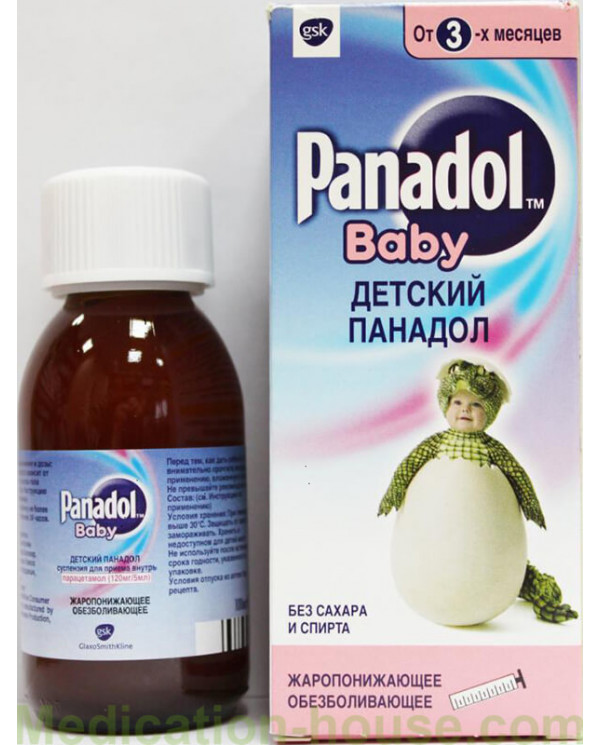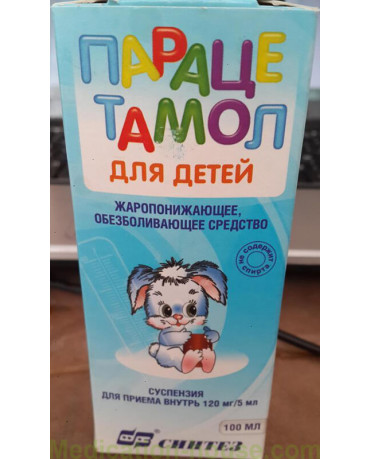Panadol baby instruction
You can buy Panadol babyhere
Release form and composition
Dosage forms of Panadol baby:
suspension for oral administration: a viscous consistency liquid, with crystals, pink in color, with strawberry flavor (100, 300 or 1000 ml in a dark glass bottle, 1 bottle in a cardboard bundle complete with a measuring syringe);
5 ml of suspension contains:
active substance: paracetamol - 120 mg;
auxiliary components: maltitol, sorbitol, 70% crystalline sorbitol, xanthan gum, citric acid, malic acid, strawberry flavor L10055, a mixture of parahydroxybenzoic acid esters (propyl, ethyl, methyl parahydroxybenzoates), dye azorubine, water.
Pharmacodynamics
Panadol baby is a non-narcotic drug with analgesic and antipyretic effects.
The mechanism of action is based on the effect on the centers of pain and thermoregulation as a result of blocking cyclooxygenase in the central nervous system (CNS).
Virtually no anti-inflammatory effect. When taken orally, it does not affect the synthesis of prostaglandins in peripheral tissues, therefore, does not violate the water-salt metabolism and the state of the gastrointestinal mucosa (GIT).
Pharmacokinetics
The drug has a high degree of absorption. The absorption of paracetamol from the gastrointestinal tract when administered orally or during rectal administration occurs quickly and almost completely, which allows it to reach its maximum concentration (Cmax) in blood plasma 0.5–1 hours after applying the suspension and after 2-3 hours - suppositories.
Binding to plasma proteins - up to 15%. Paracetamol is characterized by a relatively uniform distribution in the tissues and body fluids.
The metabolism of the drug occurs mainly in the liver, resulting in the formation of several metabolites. The main metabolite of paracetamol in children under the age of 10 years is paracetamol sulfate, conjugated glucuronide at the age of 12 years and older.
About 17% of the dose is hydroxylated; formed active metabolites conjugate with glutathione. With an insufficient level of glutathione in the body, the enzyme systems of hepatocytes are blocked by the active metabolites of paracetamol, which can cause their necrosis.
The half-life (T1 / 2) of the therapeutic dose of the drug for suspension is 2-3 hours, suppositories - 4-5 hours. Through the kidneys, 90-100% of the dose of paracetamol taken during 1 day is released; the main part - in the form of metabolites and not more than 3% - unchanged.
Indications for use
According to the instructions, Panadol baby is used to treat children in the following conditions:
fever against colds and childhood infections (including chickenpox, rubella, scarlet fever, mumps, measles), flu;
toothache (including teething), ear pain with otitis media or sore throat.
The suspension is also taken for headaches.
In addition, a single use of the drug is indicated for increasing body temperature after vaccination, including for taking the suspension in children from the 2nd month of life.
The form of Panadol baby is prescribed depending on the age of the child:
suspension: children aged 3 months to 12 years;
Contraindications
severe renal impairment;
severe impaired liver function;
combination with other agents containing paracetamol;
hypersensitivity to the components of the drug.
Additional contraindications for Panadol baby:
neonatal period, hereditary fructose intolerance;
Caution is advised to use Pediatric Panadol in case of impaired renal function, impaired liver function (including Gilbert syndrome).
Suspension and suppositories at a dose of 250 mg should be used with caution in the treatment of children with a genetic absence of the glucose-6-phosphate dehydrogenase enzyme, severe blood diseases (leukopenia, severe anemia, thrombocytopenia).
Instructions for use Panadol baby: method and dosage
Syrup Panadol baby is taken orally, after shaking the contents of the bottle.
The prescribed dose is measured using the attached measuring syringe.
A single dose for children older than 3 months is determined based on 15 mg per 1 kg of body weight. The frequency of administration is 3-4 times a day.
For children aged 2-3 months and with a body weight of 4.5-6 kg, only the doctor prescribes the dose of the drug and the frequency of use.
Recommended single dosages of Panadol baby, taking into account the age and body weight of the child:
3–6 months (with a body weight of 6–8 kg): 4 ml each;
0.5–1 year (8–10 kg): 5 ml each;
1-2 years (10-13 kg): 7 ml each;
2-3 years (13-15 kg): 9 ml each;
3–6 years (15–21 kg): 10 ml each;
6–9 years (21–29 kg): 14 ml each;
9–12 years (29–42 kg): 20 ml each.
The maximum daily dosage of Panadol baby should not exceed 60 mg of paracetamol per 1 kg of patient weight.
The duration of treatment with Syrup Panadol baby without a doctor's prescription is no more than 3 days.
In the absence of a clinical effect after the indicated period of therapy, it is necessary to consult a doctor.
Side effects
from the digestive system: very rarely - impaired liver function; sometimes - nausea, vomiting;
from the respiratory system: very rarely - bronchospasm (in children with individual intolerance to acetylsalicylic acid and other non-steroidal anti-inflammatory drugs);
allergic reactions: very rarely - skin rash, itching, Stevens-Johnson syndrome, urticaria, angioedema, anaphylaxis;
from the hemopoietic system: very rarely - anemia, thrombocytopenia, leukopenia.
In addition, with the use of the suspension, pain in the stomach can occur.
Overdose
Symptoms
During the first 24 hours - stomach pain, nausea, vomiting, pallor of the skin, sweating, anorexia. After 24–48 hours - a sensation of pain in the liver, increased activity of liver enzymes (signs of liver damage). Perhaps a violation of carbohydrate metabolism, the development of metabolic acidosis.
Liver damage occurs after taking paracetamol in a single dose: adults - more than 10 g, children - more than 0.125 g per 1 kg of the child’s body weight. With concomitant therapy with barbiturates, phenytoin, carbamazepine, primidone, diphenin and other anticonvulsants, rifampicin, flumecinol, phenylbutazone, zidovudine, butadione, hypericum preparations and other microsomal oxidation inducers or the use of hepaticol, the toxic effect of ethanol can increase occur even after taking 5 g of paracetamol.
With liver failure amid a severe degree of overdose, bleeding, encephalopathy (impaired brain function), hypoglycemia, cerebral edema (including death) are possible. The characteristic signs of the development of acute renal failure with acute tubular necrosis include pain in the lumbar region, hematuria, proteinuria, including in the absence of severe damage to liver function. Possible violation of the heart rhythm, pancreatitis.
Against the background of prolonged use of high doses of Panadol baby, the development of hepatotoxic and nephrotoxic effects (nonspecific bacteriuria, renal colic, papillary necrosis, interstitial nephritis) is possible.
Treatment
Even if there is a suspicion of an overdose and in the absence of its first symptoms, the use of the drug must be canceled and seek medical help immediately. In case of an overdose on the background of rectal administration of the drug, gastric lavage or administration of enterosorbents do not have a therapeutic effect. Not earlier than 4 hours after an overdose, the level of paracetamol in the blood plasma should be determined. Since, after an overdose, the maximum protective activity of acetylcysteine is ensured during the first 8 hours, it must be administered within the next 24 hours. With a later period of administration, the effectiveness of the antidote decreases sharply. If necessary, intravenous administration of acetylcysteine is indicated. If the patient did not vomit prior to admission to the hospital, methionine may be used. Additional therapeutic procedures are prescribed taking into account the results of studies to determine the level of concentration of paracetamol in the blood and the period of time from the moment of taking a high dose of the drug.
Treatment of patients with severe hepatic impairment should be carried out with the participation of specialists in the field of toxicology or liver diseases.
special instructions
Do not exceed the recommended dose!
In the case of preliminary treatment of the child with other medicines, the use of Panadol baby can only be started as prescribed by the doctor.
Subject to the recommended dosing regimen, paracetamol rarely causes unwanted effects.
If symptoms of side effects appear, stop taking Panadol baby and consult a doctor immediately.
If you accidentally take a high dose of the drug, even if the child is in good condition, you should immediately consult a doctor to prevent the development of liver damage.
When conducting blood tests to determine the level of glucose and uric acid, it is necessary to inform the medical staff about the use of the drug.
If treatment with the drug lasts more than 7 days, the patient should ensure control of the functional state of the liver and peripheral blood counts.
The cause of severe liver damage with an insignificant (5 g or more) overdose of paracetamol may be glutathione deficiency in the body, which can occur with indigestion, starvation or exhaustion of the patient, cystic fibrosis, HIV infection.
The use of rectal suppositories is indicated for an emetic reaction in a child and other difficulties associated with taking the drug inside.
The content of parahydroxybenzoic acid esters in the suspension may cause the development of delayed allergic reactions.
Use in childhood
Receiving a suspension during the neonatal period is contraindicated.
For children aged 2–3 months and born to premature babies, you can use Baby Panadol only as directed by your doctor.
In case of impaired renal function
The use of Panadol baby is contraindicated in severe renal impairment.
With caution, it is recommended to use all forms of the drug in case of impaired renal function.
With impaired liver function
The use of Panadol baby is contraindicated in cases of severe impaired liver function.
Caution should be exercised in the treatment of children with impaired liver function, including with Gilbert syndrome.
Drug interaction
With simultaneous use with Panadol baby:
barbiturates, phenytoin, carbamazepine, diphenin, primidone and other anticonvulsant drugs, rifampicin, flumecinol, zidovudine, phenylbutazone, butadione, hypericum hypericum preparations and other microsomal oxidation inducers, ethanol: contribute to an increase in hydroxylated active metabolites;
colestyramine: reduces the absorption rate of the drug;
inhibitors of microsomal liver enzymes: reduce the risk of hepatotoxic effects;
chloramphenicol: increases the period of its excretion by 5 times, causing an increased risk of intoxication;
indirect anticoagulants (coumarin derivatives): enhance their effect against the background of prolonged use of paracetamol, increasing the risk of bleeding;
metoclopramide, domperidone: increase the rate of absorption of paracetamol;
uricosuric agents: may lower their therapeutic effect.
Terms and conditions of storage
Keep out of the reach of children.
Store at temperatures up to 30 ° C, suspension in a dark place, do not freeze.
Shelf life is 3 years.
Reviews
The reviews of Panadol baby are mostly positive. The advantages of the drug are a convenient form (suppository and suspension) of release, significant effectiveness in pain and high body temperature, good tolerance when used in pediatric practice.
There are a lot of reviews about Panadol baby. The advantages of the suspension, according to patients, include: efficiency, quick action, pleasant taste, safety, the presence of a convenient measuring syringe in the kit, low cost, long shelf life. Among the shortcomings, it is possible to note the presence of dyes and flavorings in the composition of the suspension, the contraindications to the use of the drug, the short-term effect (reduces the temperature for 3-4 hours), as well as lack of effectiveness at high temperature. Some children were allergic to the suspension.
Terms of sell
You can buy Panadol baby without a prescription.


